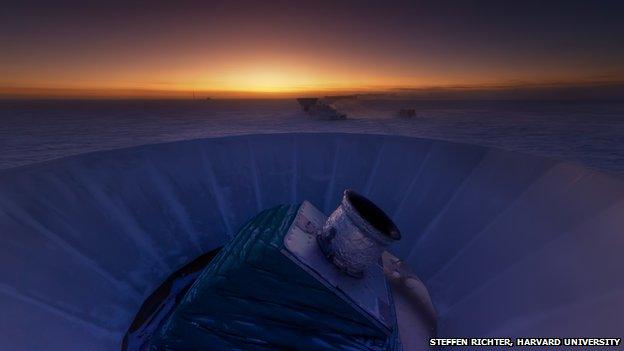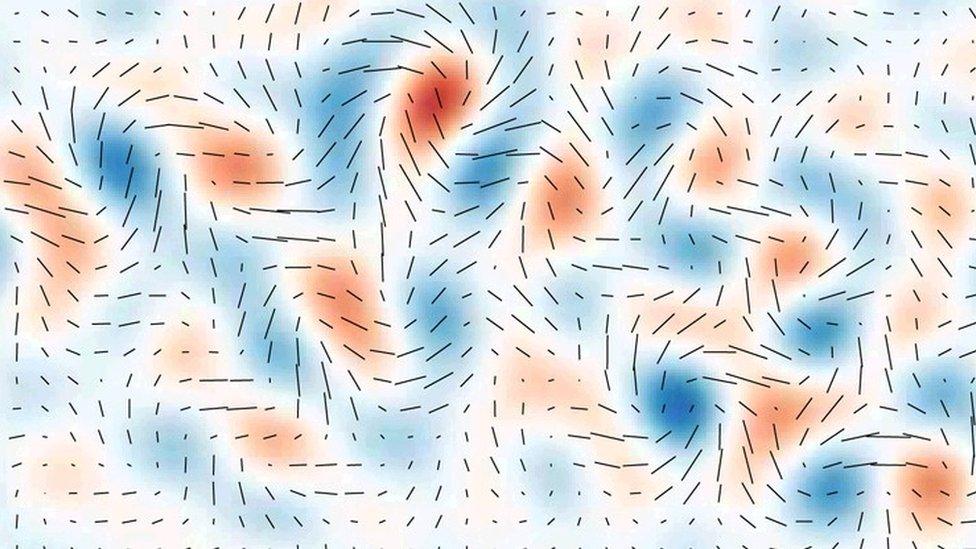Cosmic inflation: 'Spectacular' discovery hailed
- Published

The measurements were taken using the BICEP2 instrument at the South Pole telescope facility
Scientists say they have extraordinary new evidence to support a Big Bang Theory for the origin of the Universe.
Researchers believe they have found the signal left in the sky by the super-rapid expansion of space that must have occurred just fractions of a second after everything came into being.
It takes the form of a distinctive twist in the oldest light detectable with telescopes.
The work will be scrutinised carefully, external, but already there is talk of a Nobel.
"This is spectacular," commented Prof Marc Kamionkowski, from Johns Hopkins University.
"I've seen the research; the arguments are persuasive, and the scientists involved are among the most careful and conservative people I know," he told BBC News.
The breakthrough was announced by an American team working on a project known as BICEP2, external.
This has been using a telescope at the South Pole to make detailed observations of a small patch of sky.
The aim has been to try to find a residual marker for "inflation" - the idea that the cosmos experienced an exponential growth spurt in its first trillionth, of a trillionth of a trillionth of a second.

Gravitational waves from inflation put a distinctive twist pattern in the polarisation of the CMB
Theory holds that this would have taken the infant Universe from something unimaginably small to something about the size of a marble. Space has continued to expand for the nearly 14 billion years since.
Stephen Hawking debates inflation with Neil Turok
Inflation was first proposed in the early 1980s to explain some aspects of Big Bang Theory that appeared to not quite add up, such as why deep space looks broadly the same on all sides of the sky. The contention was that a very rapid expansion early on could have smoothed out any unevenness.
But inflation came with a very specific prediction - that it would be associated with waves of gravitational energy, and that these ripples in the fabric of space would leave an indelible mark on the oldest light in the sky - the famous Cosmic Microwave Background.
The BICEP2 team says it has now identified that signal. Scientists call it B-mode polarisation. It is a characteristic twist in the directional properties of the CMB. Only the gravitational waves moving through the Universe in its inflationary phase could have produced such a marker. It is a true "smoking gun".
Speaking at the press conference to announce the results, Prof John Kovac of the Harvard-Smithsonian Center for Astrophysics, and a leader of the BICEP2 collaboration, said: "This is opening a window on what we believe to be a new regime of physics - the physics of what happened in the first unbelievably tiny fraction of a second in the Universe."
'Completely astounded'
The signal is reported to be quite a bit stronger than many scientists had dared hope. This simplifies matters, say experts. It means the more exotic models for how inflation worked are no longer tenable.
The results also constrain the energies involved - at 10,000 trillion gigaelectronvolts. This is consistent with ideas for what is termed Grand Unified Theory, the realm where particle physicists believe three of the four fundamental forces in nature can be tied together.
Professor Alan Guth: "This experiment is Nobel Prize worthy"
But by associating gravitational waves with an epoch when quantum effects were so dominant, scientists are improving their prospects of one day pulling the fourth force - gravity itself - into a Theory of Everything.
The sensational nature of the discovery means the BICEP2 data will be subjected to intense peer review.
It is possible for the interaction of CMB light with dust in our galaxy to produce a similar effect, but the BICEP2 group says it has carefully checked its data over the past three years to rule out such a possibility.
Other experiments will now race to try to replicate the findings.
Prof Andrew Jaffe from Imperial College London, UK, works on a rival telescope called POLARBEAR, external. He commented: "A lot of this is technology driven. And the next generation of experiments, like the next generation of POLARBEAR, SPIDER, external and EBEX, external, and things like that, will have far more detectors and will go after this signal and hopefully drag out much more detail."
Assuming the BICEP2 results are confirmed, a Nobel Prize seems assured.
The BBC's David Shukman explains the findings
Who this would go to is difficult to say, but leading figures on the BICEP2 project and the people who first formulated inflationary theory would be in the running.
One of those pioneers, Prof Alan Guth from the Massachusetts Institute of Technology, told the BBC: "I have been completely astounded. I never believed when we started that anybody would ever measure the non-uniformities of the CMB, let alone the polarisation, which is now what we are seeing.
"I think it is absolutely amazing that it can be measured and also absolutely amazing that it can agree so well with inflation and also the simplest models of inflation - nature did not have to be so kind and the theory didn't have to be right."
British scientist Dr Jo Dunkley, who has been searching through data from the European Planck space telescope, external for a B-mode signal, commented: "I can't tell you how exciting this is. Inflation sounds like a crazy idea, but everything that is important, everything we see today - the galaxies, the stars, the planets - was imprinted at that moment, in less than a trillionth of a second. If this is confirmed, it's huge."

"Everything we see today - the galaxies, the stars, the planets - was imprinted at that moment"
Jonathan.Amos-INTERNET@bbc.co.uk and follow me on Twitter: @BBCAmos, external
- Published17 March 2014

- Published27 March 2013
- Published18 March 2013